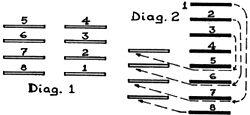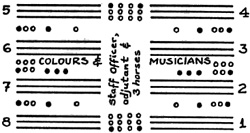The "Attack Column"
The infantry battalions were now organized into four companies drawn up in three ranks (the companies varied in strength from year to year, around 200 men each is a reasonable average).
A regiment consisted of two musketeer and one fusilier (light) battalion. The grenadier
companies were combined at brigade level to form a battalion. The marching rate was 108 paces per minute, bayonet attacks were made at 120 and a charge over short distances was made at the trot. The "attack column" was the favored formation not only for the attack, but also
for the retreat and when threataned bv enemy cavalry.
The attack column was formed from the "column of
march"; or from line as shown in FIGURE 2 and 3
respectively. The musicians were placed between the 6th
and 3rd platoons and the 7th and 2nd.
Square was formed by closing the intervals between
the platoons, filling the gaps with officers and NCO's and
by turning the flank files outwards. When in square, only
the second rank fired, the first charging arms and the third
passing their loaded muskets forward.
This article appears in MagWeb (Magazine Web) on the Internet World Wide Web. At right, DIAGRAM 1: Attack Column. Numbers indicate the platoon.
At right, DIAGRAM 1: Attack Column. Numbers indicate the platoon.
DIAGRAM 2: Attack Column from Column of March
 At left, Attack Column from Line.
At left, Attack Column from Line.
 At right, Square.
At right, Square.
Back to Table of Contents -- Courier Vol. IV No. 2
© Copyright 1982 by The Courier Publishing Company.
Other military history articles and gaming articles are available at http://www.magweb.com